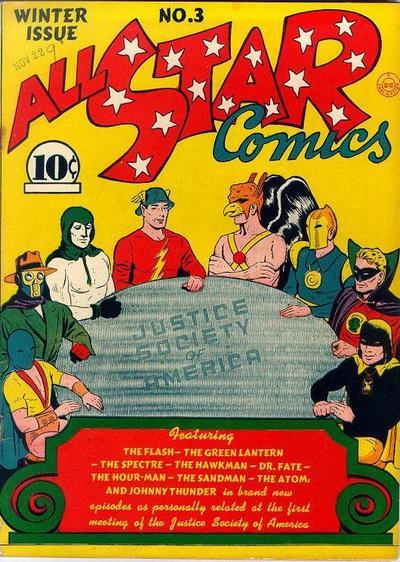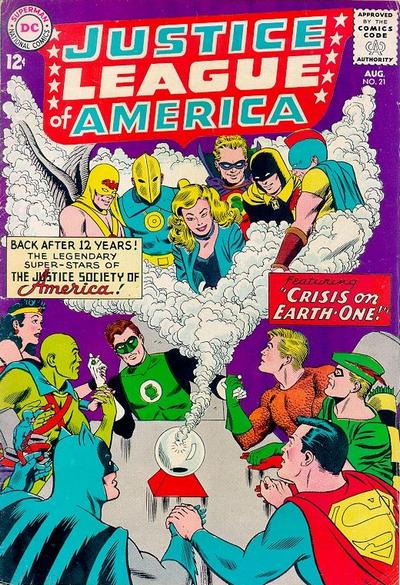Last week after I wrote about my viewpoints on History and Continuity, I got to thinking about my favorite books about the history of comics. Books like Men of Tomorrow: Geeks, Gangsters, and the Birth of the Comic Book by Gerard Jones and The Ten-Cent Plague: The Great Comic-Book Scare and How It Changed America by David Hajdu do a great job telling the history of the people behind the comics, but in my eyes they are missing an essential element. The fictional history of the characters that springs forth from creators is just as interesting to me. How much did the personal disappointments of Jerry Siegel’s life color his work on Superboy in the 1950s? There isn’t any definitive answer but insight lies in both knowledge of Siegel and Superboy. The fictional history will mirror the complicated nature of people working to together creatively to make money. It is Grant Morrison meets Wall Street. The books that scratch that itch are the All-Star Companions (four volumes) from TwoMorrows Publishing, edited by Roy Thomas.
Originally intended as a one volume companion to the origins of the Justice Society of America in All-Star Comics the project grew and grew. Roy Thomas found more and more contributors and tidbits as he went along. The project grew naturally to include the Justice Society/Justice League crossovers of the sixties, the relaunch of All-Star Comics in the 70s, the All-Star Squadron, Infinity Inc., Secret Origins, and Young All-Stars. The companions are the go to resource for information about Earth-2. The companions provide issue by issue breakdowns of each book with bits of trivia and behind the scenes info mixed in. (This was a bit of an inspiration for my own podcast.) There are biographical breakdowns of every creator who touched the titles in question. Every aspect of the fiction and the reality behind the fiction are covered. There is also room for straying to cover tangential topics as well. For instance, there is discussion of when All-Star Comics became a western title in the 50s.
All four volumes host a wealth of art. Not just covers and interiors, but unused interior art, sketches from artists, and homages to famous Justice Society moments (A LOT of homages to the iconic cover to All-Star Comics #3). Every page has a piece of visual history to enjoy. My personal favorite would be the sketches from artists, many from the personal collection of long time Justice Society fans, like Jerry Bails (The Father of Comic Book Fandom). It gives the book a personal feel that elevates it beyond the academic. It really feels like you have been invited into fan’s comic room to share in their personal passions.
The inner history nerd within me loves the duality of these volumes. They are about the history of the characters and the creators. The stories run parallel with influence flowing in both directions. The original Justice Society stories captured the imagination of Roy Thomas, who would go on to shape the history of the JSA’s world. Thomas describes the original All-Star Comics issues as a “Flash” of inspiration, and that all of his work with the Earth-2 characters would simply be accents that fit between the spaces of those original stories.
 The Justice Society hit a soft spot that fans still possess. We love to see our favorite heroes all together in one place. All-Star Comics was the biggest crossover in town. The structure wasn’t one that contemporary readers would recognize. The Justice Society would appear together at the beginning and end of the story, but would split into solo missions. This structure would necessitate a creative balancing act of epic proportions. Different artists would tackle the individual missions with the resulting book being an interesting mix of styles. It was done purely as an assembly line approach to putting the books together. There were a lot of pages and a lot of last minute shuffling going on. Flexibility was the key. As Thomas and his contributors point out; stories were shuffled around, characters were switched, and stories dropped. It was like a putting together a jigsaw puzzle and having a few extra pieces left over.
The Justice Society hit a soft spot that fans still possess. We love to see our favorite heroes all together in one place. All-Star Comics was the biggest crossover in town. The structure wasn’t one that contemporary readers would recognize. The Justice Society would appear together at the beginning and end of the story, but would split into solo missions. This structure would necessitate a creative balancing act of epic proportions. Different artists would tackle the individual missions with the resulting book being an interesting mix of styles. It was done purely as an assembly line approach to putting the books together. There were a lot of pages and a lot of last minute shuffling going on. Flexibility was the key. As Thomas and his contributors point out; stories were shuffled around, characters were switched, and stories dropped. It was like a putting together a jigsaw puzzle and having a few extra pieces left over.
The four volumes of the companion are a testament to the rich history of the Justice Society, and all of the titles the concept spawned. It is also a wonderful convenience for fans that have an interest in a specific facet of history. It isn’t a four volume narrative history so there is no need to buy each volume, unless like me, you just happen to be interested in all of it. Every volume is its own treasure trove of info. Paging back through these books always brings out new insight about fiction and fandom.
In retrospect, Earth-2 from the late 70s to Crisis on Infinite Earths was the exact sort of material that we often hear superhero fans clamor for today. There are fans that want to see what would happen if Superman  were allowed to age. We saw that in the relaunched All-Star Comics. Do you want to see Batman actually die? Yep, they covered that in an Earth-2 story in Adventure Comics. He stayed dead. Hell, everyone was allowed to age. Dick Grayson had grey in his hair. The Sandman had a stroke. The Justice Soceity had kids, and some of them were total losers (Silver Scarab..ugh.) All-Star Squadron was a favorite of mine. It was WWII stories that took place in between the gutters of the old Justice Society stories, but focused on B and C list characters. It was a series that starred Johnny Quick and Liberty Belle. FDR made several appearances. It was a quirky book about the Greatest Generation but also had Mr. Mind. Earth-2 was the weird universe where people who read comics for too long could go hang out. Roy Thomas was given free reign over a large portion of this world (writing and creating All-Star Squadron and Infinity Inc.), and there is a clarity of vision because of that control.
were allowed to age. We saw that in the relaunched All-Star Comics. Do you want to see Batman actually die? Yep, they covered that in an Earth-2 story in Adventure Comics. He stayed dead. Hell, everyone was allowed to age. Dick Grayson had grey in his hair. The Sandman had a stroke. The Justice Soceity had kids, and some of them were total losers (Silver Scarab..ugh.) All-Star Squadron was a favorite of mine. It was WWII stories that took place in between the gutters of the old Justice Society stories, but focused on B and C list characters. It was a series that starred Johnny Quick and Liberty Belle. FDR made several appearances. It was a quirky book about the Greatest Generation but also had Mr. Mind. Earth-2 was the weird universe where people who read comics for too long could go hang out. Roy Thomas was given free reign over a large portion of this world (writing and creating All-Star Squadron and Infinity Inc.), and there is a clarity of vision because of that control.
It always bothered me in Infinite Crisis when Earth-2 is brought back and all the characters are discussing it like it was a utopia. I always think of Earth-2 as the place where bad things happened to superheroes and it stuck. For me, it was a far darker world than Earth-1. Commie hunting senators forced the Justice Society to retire and the Justice Society was ultimately doomed to die again and again fighting a hopeless battle in limbo. Idyllic, right?
Just as Earth-2 was getting more complicated, the DC universe was in the process of getting simplified through Crisis on Infinite Earths. This was a collision of creativity and commerce on an epic scale. Having interviewed Roy Thomas, I know his feelings about the Crisis, which may color my view of how he handles the topic in the companions. It is mentioned in reference to changes that had to be made to books like All-Star Squadron (essentially killed it), Young All-Stars, and Secret Origins. There is a sense of frustration with how well-planted story ideas and elements would have to be abandoned and how the Justice Society would have to be pushed aside for accessibility sake. Sounds slightly familiar?
There is no Justice Society book in the upcoming DC relaunch. That doesn’t mean there won’t be one in the future, but it does mean that for right now the Justice Society is going to be put aside. The good news is that the All-Star Companions show that the Justice Society won’t stay away forever. The idea is just too good.
Tom Katers is gone fishin'


I was hoping Five Fists of Science would be brought up. The merging of fact and fiction in that book cracks me up.
the Tiki
there are some great coffee table historical books like The Les Daniels/Chip Kidd Batman/Superman/Wonder Woman/Captain Marvel complete history series and even Taschen’s DC 75th. For me those are great to see visual history through artifacts and objects…really helps me to understand the context.
“Men of Tomorrow…” is an amazing book.
The Ten cent Plague was fantastic. I would highly recommend that to anyone looking for a book on comics history.
Thank you Tom, I wasn’t aware of those All-Star Companions so I will definitely pick those up. I also love the All-Start Squadron and JSA.
And the JSA chose to stay in limbo and fight as the Norse Gods in Ragnarok to prevent Hitler from destroying the world in 1945. Nerd rant over.
Grant Morrison’s Supergods is a fascinating analysis of superhero history, as only Morrison could tell. I’m only halfway through, but my mind is already fully blown.
@MikeG Agreed, I often marvel at how Tom knows so much. Well, apparently he reads. A lot. These sound right up my alley, being a big JSA fan.
Thanks for the article, Tom!
@rapideyemovement- I thought the Grant Morrison book wouldn’t be out for a few more weeks?
Tom- True.
@joeislive So did I but I found it on sale at my LCS just this week. Now, I’m in Scotland, plus Morrison is doing a signing at my LCS next week, so maybe we just get it early?
I really like the TwoMorrows stuff. I subscribe to Alter Ego and Back Issue. Great mags which merge two of my passions: comic books and history( I have a degree in Historical Studies and 30+ years of comics collecting). These books have been on my radar for a while now. I just finished two comics related books which were pretty good: Conversations with Stan Lee and Comic Wars.